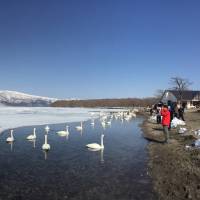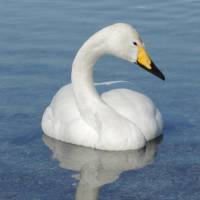Each year the "angels of winter" wing in and out of Japan. They arrive, clamoring, on the gnarled back of autumn storms, their wings and the first snowflakes flurry together as if they, too, are an integral part of the changing season.
They are swans. They linger through the coldest, bone-numbing months of winter; they seem at home along freezing rivers and lakeshores, even in ice-filled bays. Then, as if the effusion of plum blossoms is a blight on their world of winter, they leave before true spring takes its grip on the land. The first migrant swans are already moving northward through these islands, readying to head back to their Russian breeding grounds, though not without taking with them a taste of Japan's fresh green growth as it emerges from beneath the snow.
I have a passion for swans — not just any swans, though all are fascinating, but my feelings run deepest for the archetypal swan: Cygnus cygnus, or the whooper swan. I also have a passion for hot water — not just any hot water, natural thermal springs are my thing. There is only one part of the world where I can indulge both passions simultaneously — Japan's northern isle of Hokkaido. Here I can sit neck-deep in mineral-rich hot water and listen to the stirring calls of flocks of migrating swans passing overhead. On the shores of Lake Kussharo, eastern Hokkaido, I have a choice. I can shiver in temperatures that may touch minus 25 degrees Celsius during mid-winter as I count and photograph the swans that gather near the water's edge soon after dawn; or, instead, I can ease myself into an outdoor hot spring and watch them from there as I turn pink from the heat. It's really a no-brainer.
In a sense, it was the white wings of the angels of winter that brought me from Britain to Japan 35 years ago. I first visited northern Honshu and Hokkaido in February 1980 to combine attending an international conference on swan and crane biology in Sapporo with swan research, and, here in Hokkaido, I found my eventual and natural home. My research into behavioral ecology led me toward the world of writing, first tentatively and academically, then for the popular press. When I returned to Japan in early 1982, armed with a newly awarded doctorate, I found that I was able to combine my interests in wildlife and writing thanks to the foresight of the late Gyo Hani, then-managing editor of The Japan Times, who took me on as a columnist, launching Wild Watch on April 2, 1982. At that time, the paper featured few reports on science or the natural world. Hani encouraged me to explore natural and scientific diversity, reporting and reflecting on my personal experiences and encounters with the natural world of Japan in my writing. I took his suggestions to heart and have done exactly this for more than three decades, until this month, when The Japan Times informed me it had decided to bring the column to a close. Never fear, dear reader, my column moves to a new venue from next month and you can continue to read my natural ramblings at Japan Nature Guides.
I began watching whooper swans almost 40 years ago in Scotland and continue to this day. Their mysterious beauty draws me to make pilgrimages to watch them each winter. Flocks arrive in Hokkaido from their boreal breeding grounds in Chukotka and Kamchatka, having been driven south by the arrival of the early autumn icing that can trap unfledged cygnets or even isolate them from their food supply.
In Japan, these magnificent birds find sufficient food to survive safely over-winter and gather at many locations in flocks of dozens, even hundreds. At some of those sites, volunteers provide the very food that attracts these inspirational creatures. Few birds, other than perhaps Red-crowned cranes and Steller's sea eagles, can claim to draw so many photographers from across the world to Japan in winter.
Gracefully elegant and seemingly angelic, whooper swans are, on occasions, boisterous and aggressive. Mostly this is in the form of noisy clamoring, neck-stretching displays and jousting thrusts with their long necks and bills. However, whenever they feel their family's feeding patch has been encroached upon, males will resort to no-holds barred fighting. They grasp with their beak, thrash with their wings and kick with their feet, sending water spraying and eventually their opponents fleeing. The male and female then turn toward each other and perform an emotional display, combining success with relief. They have strengthened their own bond and successfully defended their family against intruders. In this way, there is a pecking order among families, pairs and singletons, with those with larger families usually dominant. Where food is found, the very same swans may put such aggression aside and gather so closely that their creamy-white wings and creamy-white backs are arrayed like densely arranged pillows of snow, with no water showing between them!
They gather in flocks when grazing on land, too, and gain safety benefits by being amongst the crowd. While mostly feeding, each swan occasionally pauses to lift its head and look around, and the randomized way in which this happens means that some flock members are always vigilant. As a consequence, they all benefit; the group vigilance makes it difficult for a predator to surprise them and easy for the flock to respond to any potential danger, human or otherwise.
Make the journey from Britain to Japan by air, and the great circle route your aircraft follows takes you across the greatest swathe of swan habitat in the world. Much of this vast boreal area, commonly referred to as Siberia, lies within the whooper swan's domain.
Scientists have been tracking swans by satellite, allowing us to understand so much about the movements of these birds. Swans that have spent the winter in northern Honshu will rest in Hokkaido, then Sakhalin, and near the mouth of the Amur River, on their way north to breed in the Indigirka and Kolyma River drainages. This is a far cry from what scientists knew about migration routes when I first began studying whooper swans on their wintering grounds in Scotland, and on their breeding grounds in Iceland in the late 1970s and early '80s.
Our knowledge continues to grow, for these large birds are easily watched, relatively approachable and easily studied. However, much still remains to be learned, with questions ranging from the esoteric — How many have blue eyes? How many are orphaned and adopted? — to the essential: Which migratory resting sites are vital to them and, hence, important to conserve? In Western Europe, their movements and migrations are relatively well-known, their breeding haunts mapped, many of their resting sites are protected and their wintering grounds famously advertised, as is the case in Japan. However, in the main migratory ranges, east of Europe and west of Japan, even population estimates are largely speculative, and we know next to nothing about where they pause, or winter. The largest part of their route is filled with unknowns.
I began as a swan novice, became a specialist while researching swan biology full-time, then while writing a monograph on the whooper swan I completed the academic circle back to novice again, and confirmed just how little I knew, and how much more there is to learn, not just about swans but about so much of our natural world. One thing I know for sure, though, is that the very best way to watch whooper swans is from a piping hot bath, as they swim like angels of winter through the morning mist rising from the edge of a sparkling, snow-covered frozen lake in eastern Hokkaido.
I have enjoyed entertaining you with my writings in my Wild Watch column over the years and I hope that you will continue to find hope and inspiration in the natural world.
This is the final installment of Mark Brazil's Wild Watch column, which he has written for 33 years. Wild Watch moves to www.japannatureguides.com from April.
Mark Brazil has written "Wild Watch" for more than 30 years. He also organizes and leads wildlife, birding and photographic excursions around Japan. His latest book, "The Nature of Japan: From Dancing Cranes to Flying Fish," is available from www.japannatureguides.com or from the Junkudo Ikebukuro bookshop in Tokyo.





















With your current subscription plan you can comment on stories. However, before writing your first comment, please create a display name in the Profile section of your subscriber account page.